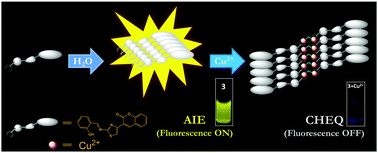Ultrasensitive detection of aqueous Cu2+ ions by a coumarin-salicylidene based AIEgen†
Abstract
This work reports the aggregation induced emission (AIE) behaviour of a coumarin-salicylidene Schiff base probe 3 which shows bright yellow AIE fluorescence in DMSO–water medium (fw 80%) buffered by 10 mM HEPES at pH 7.4. The aggregated probe (AIEgen-3) selectively discriminates Cu2+ ions over a series of other interfering metal ions via a fluorescence “on–off” strategy through a CHEQ process. DLS measurements revealed an average particle size of 372 nm for AIEgen-3 at an 80% water fraction, which dramatically increases to 656 nm in the presence of Cu2+ ions, indicating the formation of more structured aggregates, which was further supported by TEM and ESI-MS experiments. A comprehensive analysis of the binding characteristics and interference studies of AIEgen-3 with various metal ions have been carried out by fluorescence and UV-visible experiments. AIEgen-3 shows a fluorescence detection limit (LOD) of 24 nM (∼1.5 ppb) for Cu2+ ions, which is considerably far below the values of detection limits recently reported for other Cu2+ ion sensors in aqueous medium. Further, the analytical applications of AIEgen-3 have been demonstrated by the estimation of Cu2+ ions in tap water and pharmaceutical samples both in solution and the solid phase, which shows the potentiality of the probe for on-site detection of Cu2+ ions in chemical, environmental and biological samples.

- This article is part of the themed collection: Recent Progress on Aggregation-Induced Emission


 Please wait while we load your content...
Please wait while we load your content...